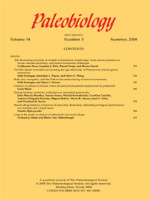Among polygynous mammals, a heightened risk of mortality is linked to the intensity of intragender competition and life-history stages, such as sexual maturity, where inexperienced individuals are vulnerable to the aggressive behaviors of dominant individuals. In this respect, the age- and sex-specific mortality patterns found in fossil assemblages could be informative of sociality in extinct species. This possibility was explored by comparing the age- and sex-specific demography of attritional rhinoceros assemblages, Teleoceras proterum (n = 2) and Aphelops malacorhinus (n = 1), from pond and fluvial sedimentary facies of the late Miocene of Florida, with modern skeletal assemblages of extant rhinos and other large mammals.
Subadult and young adult males (between 15–40% of potential life span) numerically dominate the Teleoceras assemblages, indicating a disproportionately high frequency of localized young male mortality. The estimated age-specific mortality rates indicate elevated mortality risks among males at an age equivalent to the years encompassing male physiological and social maturity in modern rhinos, a pattern that suggests a high frequency of socially mediated mortality. Age-specific mortality rate curves of modern black rhino populations are essentially identical. A high frequency of intraspecific fight-related mortality characterizes modern rhinos and strongly suggests that elevated Teleoceras mortality was influenced by intragender competition. Although Teleoceras is widely believed to have been the analog of extant Hippopotamus, mortality rates of young males are not elevated in a modern Hippopotamus population. The Aphelops assemblage is not significantly male-biased and does not indicate elevated mortality rates of young males, suggesting that aspects of Aphelops sociality differed from modern rhinos. Although the nature of Aphelops sociality is not clear, aggression toward young males may have been less extreme or less frequent in Aphelops populations.





